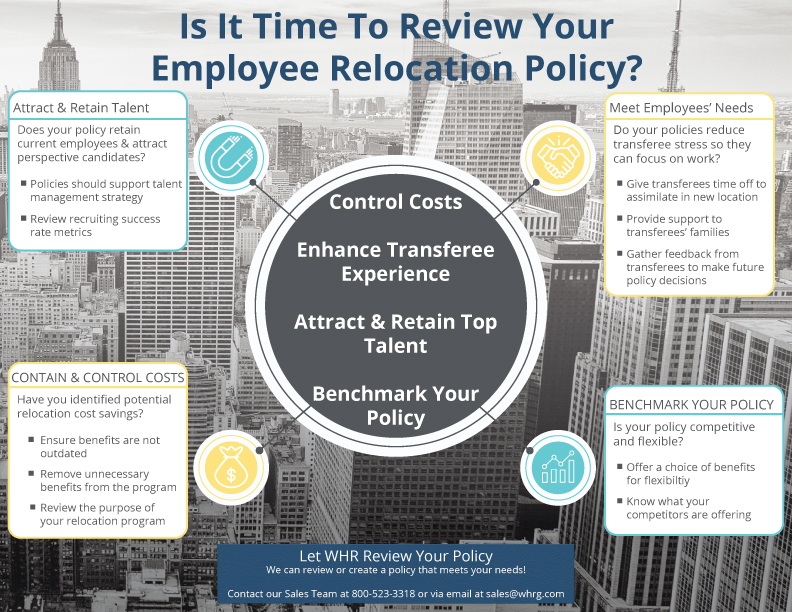Dados los numerosos cambios que las empresas se han encontrado a partir de la COVID-19, incluido el trabajo a distancia de los empleados, es posible que pienses que no hay razón para revisar la política de reubicación de empleados de tu empresa en este momento. Pues piénselo otra vez. Muchas empresas siguen reubicando empleados para cubrir puestos necesarios. Revisar su política y hacer los ajustes necesarios ahora puede ayudar a su organización en las siguientes áreas:
- Controlar los costes de la empresa
- Asegurarse de que se satisfacen las necesidades de los empleados
- Atraer y retener a los mejores talentos
- Evaluación comparativa Su política frente a la competencia
Los siguientes ejemplos proceden de revisiones de políticas que WHR Global ha realizado para sus clientes. Estos ejemplos demuestran lo importante que es revisar periódicamente su política de reubicación.
A. Controlar los costes empresariales y dejar de pagar por prestaciones innecesarias
Asegúrese de que está asignando la cantidad de dinero adecuada tanto a las personas trasladadas como a las necesidades de la organización. También es esencial que no pagues prestaciones innecesarias o anticuadas.
- Ejemplo nº 1
Unaempresa cuya política revisamos daba a cada trasladado una suma global estándar de entre 5.000 y 10.000 dólares por traslado para ayudar a sufragar los gastos adicionales. También daban a los ejecutivos una suma global equivalente a 6 semanas de salario, además de la suma global de 5.000 a 10.000 dólares. Como algunos ejecutivos tenían sueldos elevados, esta asignación a veces equivalía a 50.000 dólares por ejecutivo. Tras una revisión, recomendamos a la empresa que redujera esa práctica para los ejecutivos. La empresa se ahorró cientos de miles de dólares. - Ejemplo nº 2
Un cliente pagaba un diferencial por el coste de la vida si el empleado se trasladaba a una zona más cara. Lo pagaban durante 3-4 años, y además ofrecían una prestación a tanto alzado. Recomendamos un umbral mínimo del 5% por coste de la vida para que no tuvieran que pagar a las personas trasladadas a zonas con un coste de la vida ligeramente superior. El cliente ahorró millones. - Ejemplo nº 3
Otro cliente concedía primas no promocionales a los empleados actuales dispuestos a trasladarse para ocupar un puesto lateral. Estas primas equivalían al 5% del salario de los empleados. Como esta práctica no es habitual, les recomendamos que la eliminaran de su política de recolocación, lo que les ahorró importantes costes sin reducir el valor de su programa. - Ejemplo nº 4
Uno de nuestros clientes estaba pagando una comisión de apertura de préstamo. Algunos prestamistas ni siquiera cobran esta comisión, pero si saben que el cliente la pagará, la cobrarán de todos modos. Una vez que el cliente se dio cuenta, dejó de pagar la comisión a menos que fuera necesario.
B. Satisfacer las necesidades de sus empleados
Es importante que su política de reubicación satisfaga las necesidades de sus trasladados. Esto ayuda a reducir el estrés de los trasladados para que los empleados puedan centrarse en el trabajo en su nueva ubicación. Conceder tiempo libre a los trasladados para que se asimilen a su nueva ubicación, ofrecer apoyo a sus familias y recabar opiniones tras el traslado para tomar decisiones políticas en el futuro contribuirán a satisfacer las necesidades de los trasladados.
- Ejemplo nº 1
Uno de nuestros clientes ofrecía una prestación a tanto alzado para todos los traslados internacionales. Al recopilar los comentarios de la encuesta posterior a la reubicación, descubrimos que los trasladados intentaban coordinar sus propios envíos internacionales de enseres domésticos (HHG) y no gastaban la suma global completa, con la esperanza de conservar algo de dinero. Los resultados de la encuesta también mostraron que dar a los empleados ese nivel de elección les añadía más estrés y hacía que el proceso de traslado fuera más largo. Básicamente, los trasladados intentaban hacerlo todo por su cuenta y además ahorrar dinero. El cliente consideró todas las prestaciones clave y determinó que el pago único no funcionaba. Pasaron de una prestación a tanto alzado a una prestación básica flexible. Esto significaba que el cliente cubriría los envíos HHG, los proveedores de servicios de destino y el alojamiento temporal, pero seguía dando a los trasladados una cantidad a tanto alzado para que la utilizaran a discreción de los empleados. Esto no sólo ayudó a reducir el estrés de los trasladados, sino que también contribuyó a controlar los costes empresariales.
- Ejemplo nº 2
Un cliente no ofrecía servicios de destino a los cónyuges/parejas y familias de traslados intraeuropeos. Suponían que si una persona trasladada o su familia se trasladaba de Rusia al Reino Unido, por ejemplo, los servicios de destino no eran necesarios. A través de los resultados de la encuesta posterior al traslado, se determinó que los cónyuges/parejas necesitaban asistencia profesional, formación lingüística y ayuda con la búsqueda de colegio para sus hijos. El empleado tenía oficinistas que le ayudaban a asimilarse en los nuevos lugares, pero las parejas de los trasladados tenían dificultades con el nuevo idioma e incluso para encontrar artículos de primera necesidad, como tiendas de comestibles. Reconocer las necesidades de toda la unidad familiar, y no sólo del trasladado, es crucial para garantizar el éxito del traslado y la asimilación.
C. Atraer y retenerel talento y comparar su política con la de la competencia
Es de esperar que su política de reubicación ya forme parte de su estrategia total de recompensas y gestión del talento. Una política adecuada ayudará a su empresa a retener a los empleados actuales y a atraer a posibles candidatos. Una política de reubicación débil podría tener un impacto negativo en su tasa de éxito de contratación.
Comparar su política con la de otras empresas le ayudará a seguir siendo competitivo en la guerra por el talento. Asegúrese de que su política permite elegir entre varias ofertas, ya que las políticas de reubicación se incluyen en las ofertas de empleo. Si no compara su política con la de sus competidores, no sabrá si sus ofertas son buenas o no. ¿Son inferiores a lo que ofrecen los demás? Si está contratando ejecutivos de alto nivel, por ejemplo, y el talento es muy específico y no es fácil de conseguir, querrá asegurarse de que es competitivo con el salario, los beneficios y su política de reubicación.
Al mismo tiempo, la evaluación comparativa le garantizará que no está regalando demasiado cuando ninguno de sus competidores lo está haciendo. Comparar su política con la de los demás demuestra que está en consonancia con el sector. También es importante no solo analizar su sector, sino también otros sectores con los que compite por el talento.
- Ejemplo nº 1
Imagínese que pierde a un candidato potencial porque su política de reubicación no incluye prestaciones que sí incluyen sus competidores. Por ejemplo, si su candidato es un ejecutivo que espera una indemnización completa, pero su política sólo incluye un traslado HHG y el pago de una suma global, tendrá que ir y venir negociando con sus superiores y el candidato. Esto puede hacerle perder mucho tiempo. Mientras tanto, el candidato puede recibir una oferta de trabajo mejor, que incluya más ventajas de traslado. La política de recolocación puede ser un factor determinante para que los candidatos se decidan por un trabajo u otro. Si ha comparado su política con la de la competencia, ya sabrá qué incluyen.
- Ejemplo #2
Uncliente estaba recibiendo comentarios de su equipo de adquisición de talento de que era difícil cubrir ciertos puestos. Tras revisar su política y compararla con la de sus competidores, descubrimos que la competencia ofrecía beneficios de reubicación mucho mayores. Como resultado, la empresa decidió ampliar su gama de puestos de trabajo con derecho a prestaciones de reubicación completas.
D. ¿Con qué frecuencia debe revisar su política?
WHR le recomienda que revise su política de reubicación de empleados anualmente o, como mucho, cada dos años. No tiene por qué ser una revisión a fondo, pero es una oportunidad para hacer una pausa y analizar las opiniones de los empleados. Además, debe confirmar cualquier cambio en la cultura de su empresa, los principios rectores, los valores fundamentales, la estrategia de talento, el sector y la competencia. La revisión es el momento de asegurarse de que su política está en consonancia con todos estos elementos y con las principales partes interesadas (equipos de adquisición de talentos, equipos de contratación, socios empresariales de RR.HH.).


